Are we seeing a new direction in weeds?
Have you noticed that there are more ‘weeds’ in gardens now?
And those weedy gardens often look very beautiful. Some of the prettiest gardens now unashamedly seem to have weeds sprouting alongside the bedding.
Garden designer Jack Wallington calls it ‘designing with rebel plants.’ His book Wild About Weeds’ shows you how to go with the weeds in your garden, rather than spending all your time fighting them.
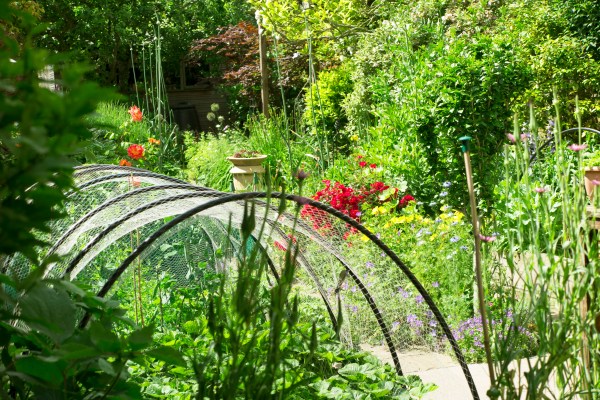
Mary and John Cousins’ from Faversham Open Gardens & Garden Market Day. You can see the wild salsify front centre and on the right of the photo in clumps in the vegetable patch.
I’ve been photographing gardens in Faversham Open Gardens & Garden Market Day held every year on the last Sunday of the month. I found weeds were welcome in several gardens, even by quite serious and knowledgeable gardeners.
Weeds in borders
So are we seeing a trend towards weeds in borders? Feel free to tell me that all the best gardeners have always left their favourite weeds in situ.
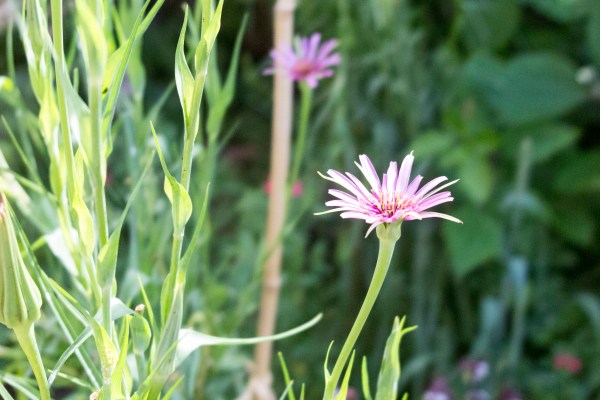
Tragopogon porrifolius or wild salsify grows on the marshes near Faversham. Kind birds drop the seeds in our gardens – seen above in elegant clumps in Mary and John Cousins’ garden. It’s too beautiful to wrench out.
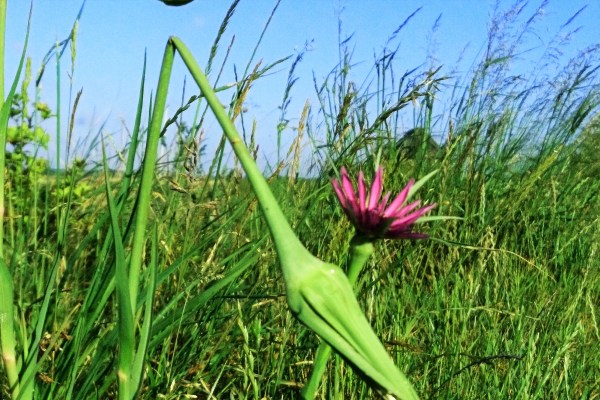
Oare Marshes. In late May there are banks of pink salsify turning their heads to the morning sun.
Purple toadflax or lunaria purpurea
It always gave me a pang to pull out the tall purple spires of toadflax scattered through my garden.
But when I visited Jack and Carolyn Wahlberg’s garden, I was impressed that Carolyn just lets the purple toadflax roam around the garden.
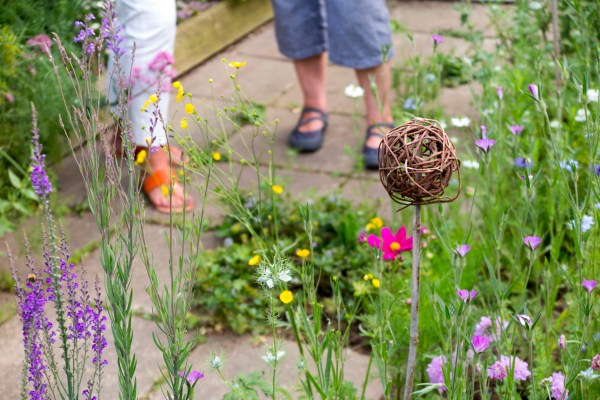
Purple toadflax in Jack and Carolyn Wahlberg’s garden.
I went home and photographed mine. I’m delighted to think it can stay.
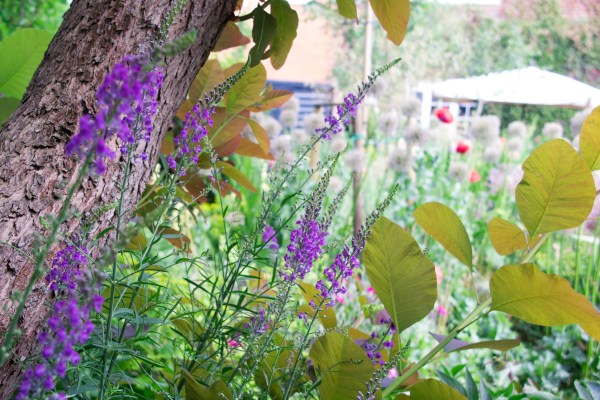
Purple toadflax grows under a tree in heavy shade in my garden – and lasts well as a cut flower, according to my researches.
Centranthus ruber or red valerian
I wasn’t sure if the clump of valerian that sprouted beside my dahlias was a weed or not.
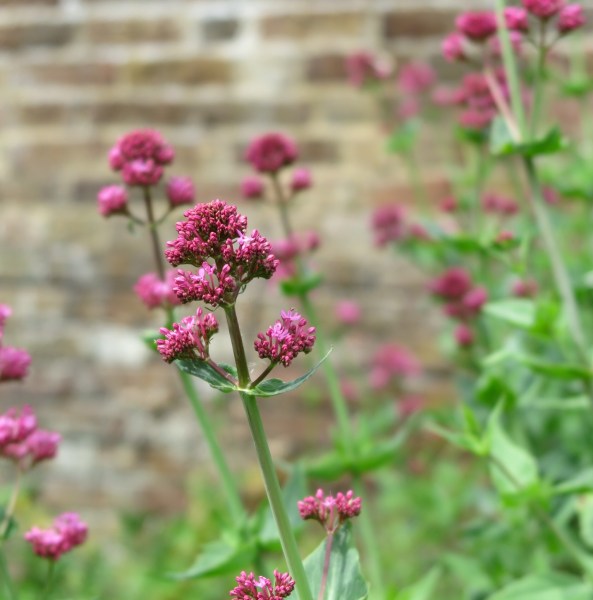
Very pretty, but over a number of years, the garden was neglected. The valerian took root in the brickwork and the bricks are all now being replaced.
It’s listed as a ‘bee-friendly’ plant by the RHS, but gardening friends tell me it is also a weed. It grows out of walls, and in coastal sites, so it’s extremely useful. I first fell in love with it when writing a post about Tom Croft’s garden. However, it has eaten into the brickwork…
Perhaps it’s a good idea to be very firm with weed-flowers in your beds.
Wild mallow or malva neglecta
This has a strong architectural shape and sweet little pink flowers. It’s trying to elbow an echinops out of my border. But I think it’s pretty, so I’ll see who wins.
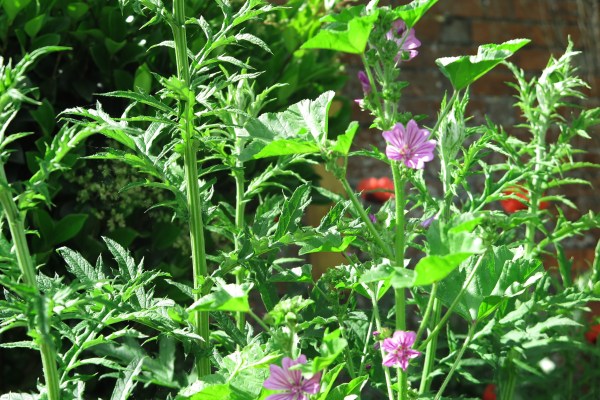
Malva neglecta or wild mallow
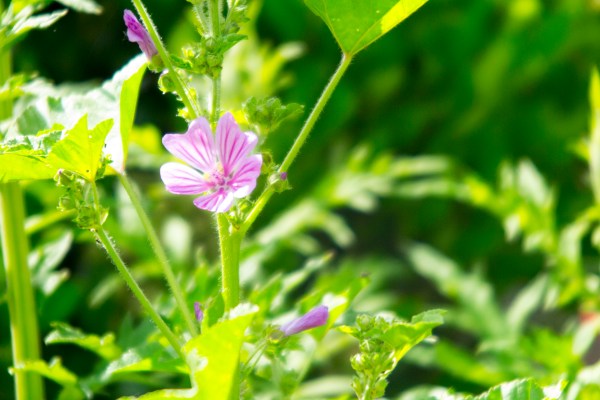
And close-up. It’s another visitor from nearby Oare Marshes nature reserve.
Poppies
I often pass a house that always has the most beautiful purple poppies in mid-summer. We have poppies in this garden, but they’re red. I say ‘we have’ rather than ‘we planted’ because we didn’t plant them. I have no idea how they arrived, but at the moment they are the only splash of colour. Farmers refer to poppies as weeds, but I suspect that in gardens they are wildflowers.
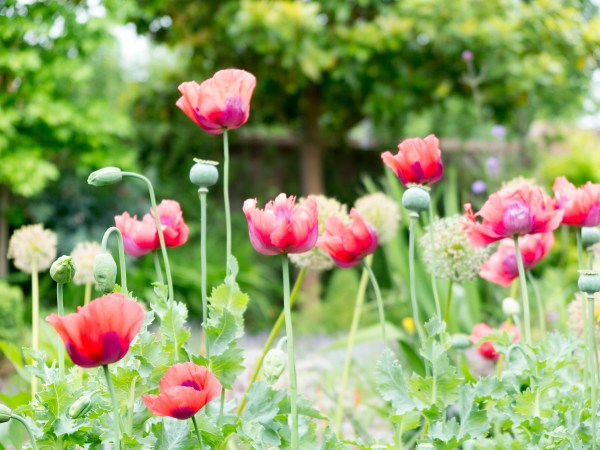
Poppies in my garden in mid- June. They bridge the gap between the alliums and the lavender.
Borage
Is borage a weed? I definitely didn’t plant it. It’s being quite thuggish, but beautiful in May so I have decided to keep it. Not that my opinion seems to matter – if I chop it down, it pops back the following year.
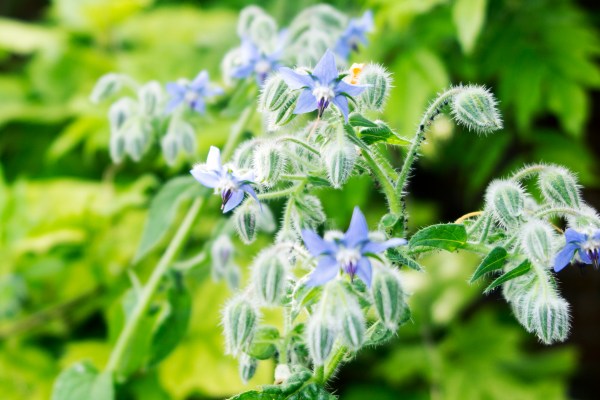
Borage. Supplied by a kind bird. But I think it’s a weed.
Oddly enough, another thing these ‘weeds’ have in common is that some are edible (not loosestrife or this kind of valerian).
You can forage for wild salsify, eat borage flowers in Pimms and ‘true’ valerian is used to help anxiety and sleeplessness. All parts of wild mallow are edible and it is considered a ‘superfood’ nutritionally (although apparently it has a boring taste.)
I’m a nervous forager. I would only want to you try eating weeds if you had checked with at least three other independent sources that they were safe. Because there are always side effects to worry about!
They say that a weed is only a flower out of place. In some parts of Australia, agapanthus is classified as an invasive weed.
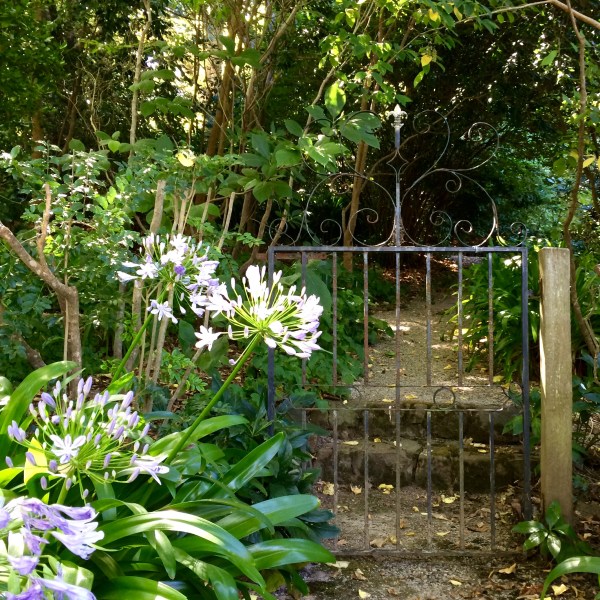
Agapanthus is considered an invasive weed in some parts of Australia.
There are some weeds which really don’t do your garden any good. And there are also weeds which you may not like. If you’re interested in getting rid of those, then see the different expert approaches in The No-Nonsense Guide to Weeding Your Garden Easily.
So what weeds have you got growing in your garden? Do you think we are getting more relaxed about weeds – and is that a good thing?
Do read about Jack Wallington’s approach to weeds or find out more by buying his book, Wild About Weeds.
Pin this for later:
And do join us every weekend – see here for a free email with more tips, ideas and inspiration for your garden.
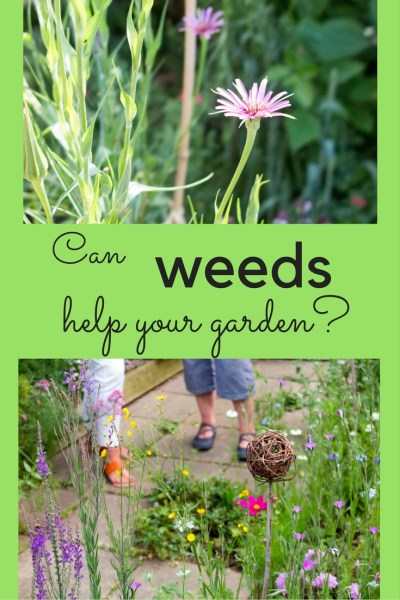
























A weed is just a plant out of place. Some weeds are horrid. I have grown some with lovely flowers that had a nice scent and the pollinators loved them. It took me many years to identify and learn about many of them. A neighbor lady (part of a garden club) criticized my “weeds” and I responded: “unlike most of your plants, I can eat most of mine and they have medicinal properties too!”
Sounds excellent.
On my allotment I have comfrey that just appeared, as it is very useful I encourage it’s growth. I also have poppies and feverfew. The bees like them so they can stay. :-)
Comfrey is lovely.
Some ‘weeds’ are so beautiful! And pollinators love them too…if this is the new trend, bring on the weeds!
Indeed!
Interesting to see the plants that exploit the opportunities in an urban setting reflect the character of the surrounding landscape, especially those plants adapted to the relatively extreme condition of marshland. Gardening in villages of the Syndale Valley (Newnham and Doddington), we have a tendency to encounter invaders associated with hedgerow/woodland habitats, including hogweed, wood avens, lords and ladies, ladies smock, bryony, campion and bluebells. The spontaneity they create is worth the limited effort of thinning out excessive growth and help blend the garden into the wider landscape.
And what delightful names they have.
Strange idea of weeds there! Some of my favourite plants. Come and see my bed of ground elder some day……Xxx
I long to see your bed of ground elder. I have several such myself and it is very pretty in flower, but in a garden this size it would take over if I didn’t wrench it out from time to time.
Visiting the famous gardens in Kent this week on a garden tour I saw that lots of them were overflowing with the plants you have mentioned and I would be happy to have valerian and borage in the garden as long as I didn’t let them thug out other things.
I’m eyeing up my valerian – I think it can stay, but the borage is definitely a thug, though very pretty. Hope you had a good tour of Kent gardens!
I definitely subscribe to the view that a weed is a plant in the wrong place. I have a colour scheme in a flower bed and self seed themselves around every year and pop in spring all over the place. If they appear in a place where they fit the scheme they stay, if not, they go! I have a white border, in which a pink foxglove has just opened – it will have to go. I also have some wild garlic in a woodland area. Yes it spreads but not horrendously so (yet!). I even leave the creeping butterfly to creep as far as the area devoted to yellow flowers, and rip it out if (sorry, when) it goes further. And of course every garden should have a few nettles somewhere discrete, for the caterpillars, but if it pops up between the achillea and the geum, then its a weed!
You’re very brave to keep creeping buttercup, but you are right, it is really pretty. I have a ‘yellow’ border (full of non-yellow self-seeders, of course) so I will maybe follow your lead and not weed the creeping buttercup out of it.
I often think that sometimes ignorance really is bliss. If we could appreciate each plant for what it contributes, rather than recognising some as “weeds” and some as desirable “plants”, it would be much easier, and could possibly lead to some much more interesting gardens! But yes. I do think we are seeing a new direction in terms of weeds. With “no-mow” and wildflower meadows on every scale seemingly becoming more and more popular, the line between nuisance weed and desirable wildflower is definitely blurred!
I’m glad you agree!
I live by the old adage that a weed is merely a wildflower in the wrong place. My father curses the native bluebells in his garden, whilst I wish they’d spread a bit more in mine. Wild Garlic is slowly establishing itself, and I’ve tried to get Linaria established, but it struggles in our back garden, whilst happily growing at the road edge. Red Valerian led to too much repairwork, so much as I love seeing it in the wild I’m trying to ensure it’s banished from the garden. Some thuggish plants like Herb Robert are tolerated in small patches, and I put up with clumps of one of the dead nettles as my wife likes it so much. Sweet Woodruff is a saviour in our shady garden.
Native bluebells would be wonderful – I keep ripping the Spanish ones out of mine. I bought some wild garlic but gave it to a friend with a woodland garden because everyone told me that it’s a thug. But it is lovely, and wonderful in soups and salads.
Just testing here to see if the comment goes through! Using Chrome instead of Safari…..
It did, indeed. Thank you – it’s been an intermittent problem but it helps to know that commenting works better on Chrome than Safari.
I certainly think that a number of those species you mention would be welcome in many a garden, they lend a cottagey air to planting and are certainly welcome in my garden!
That’s good to hear – I wonder if you see many weeds in the beautiful gardens you visit for your blog?
Do you know Thomas Rainer’s work? I heard him talk this spring about layering plants/gardens and the varying “sociability” of different plants…and all about weeds. This article was in the NYTimes recently: https://www.nytimes.com/2017/04/30/style/understanding-what-makes-plants-happy.html?_r=0
His new book is fabulous and got me thinking all about under planting!
I’ll definitely check it out, thank you.
Loved this article because I too have many of these ‘weeds’ in my garden and I encourage them all and only pull them out when they are getting a bit too big for their boots.
I came from a garden full of purple loosestrife to one full of purple toadflax and I also thought your photos were of toadflax due to their more strap-like leaves and snapdragon-like flowers. However, the test I always use for telling a purple loosestrife from anything else, is to feel the stem. If it’s loosestrife, the stems have squared sides rather than smooth, cylindrical ones.
Toadflax definitely deserve a place in any garden for their long flowering period – and they are easy to remove if they get out of hand. I’m also currently trying to encourage some purple loosestrife to self-seed around the pond as they don’t mind getting their feet wet.
My garden is very heavy (blue) clay so I’m grateful for any self-seeders. Another one I would definitely add to the list is Pilosella aurantiaca (Orange hawkweed) – such a bright addition to any slightly wild part of the garden in June.
Thank you – that’s a really useful tip. I pored over photos of loosestrife and toadflax and have come to the conclusion that everyone who has so kindly commented is right: it is toadflax in this post
Interesting article at this time as there were most certainly weeds in many of the Chelsea 2017 gardens this year- this must surely mean they have come in from the cold!!
I’m thrilled to hear it!
Lovely article and beautiful pictures! I wish I lived near the sea and could count salsify as a weed in my garden. I also thought that Centranthus ruber was lovely till it took over my border so it’s all out now. Please just be aware that it isn’t true valerian and therefore should not be used for medicinal properties.
As usual I’ve really enjoyed your post. Thank you!!
Thank you and also for the tip about the valerian.
Red campion raids my borders. Definitely too pretty to pull out, until it starts to flop (the winds this week have seen to that!) and then it does have to go.
The winds! Everything is flattened here. The link to your blog came up as an ‘error 404’ message, so I’ve re-added it here:https://www.rustyduck.net/ (Jessica’s blog, for anyone wondering).
Valerian you know I swear it could grow in mid air! I don’t get it where I live well not so far but my parents have a neighbour who loves it and it tries it’s best to take over the gravel garden.
Being disabled I’m not terribly picky about weeds unless they’re going to strangle any shrubs. My front garden however is a bee’s delight covered in dandelions, I have two to large for me lawns (weed patches) I do try to get it cut before they set seed, the birds love the insects the bee’s love the pollen so whilst it doesn’t look tidy or pretty it’s feeding natures wildlife, what’s not to like :)
It sounds wonderfully wildlife friendly.
What you call purple loosestrife (Lythrum sailcaria ) Is actually linaria or toadflax I have it in y garden in pink as well as purple it is a beautiful plant which goes very well in flower arrangements as well as the garden.
Thank you for letting me know – I will correct!
Loved your article on growing weeds in the garden! Personally, I have a new garden in Lillooet, BC, Canada, a really dry area in the western mountains. because I am new here, many of the native plants and “weeds” are new to me. Some of them are quite lovely, especially when given a it of attention, so I allow and actively transplant them into my garden to see what will happen.
I have yellow dock (quite thuggy but reliable even without added water), giant mullein (architectural but reseeds all over), red -leafed (looks like red-leafed hostas), wild salsify (had to remove it as I couldn’t get it to grow in groups where I could enjoy the seed heads) and many others.
So many weeds and weedy shrubs really are beautiful and do well in the environment as well. It’s a shame not to at least give them a chance in the garden!
Good luck, it sounds beautiful.
I too love the flowers of salsify, though they always close by midday., hence the name ‘Jack go to bed at noon’. But it looks to me as though the plant referred to as loosestrife might be the purple toadflax, linaria purpurea. I have sown seeds of the pretty pink “Canon Went”, but the majority produced the common purple form, but they are very pretty in a posy in a vase and last a long time.
You are right, I think, thank you, and I will correct.